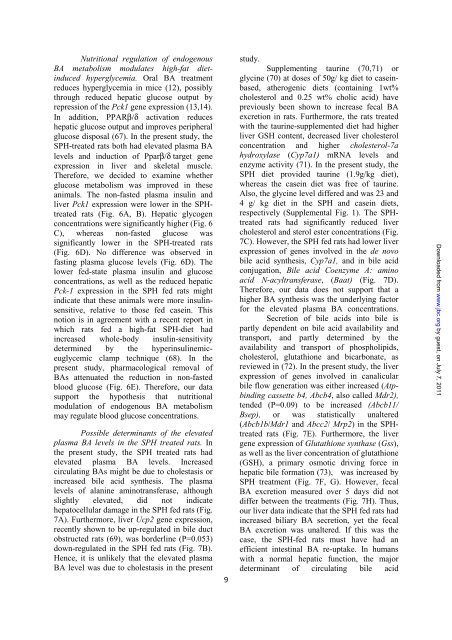The obesogenic effects of polyunsaturated fatty acids are dependent ...
The obesogenic effects of polyunsaturated fatty acids are dependent ...
The obesogenic effects of polyunsaturated fatty acids are dependent ...
Create successful ePaper yourself
Turn your PDF publications into a flip-book with our unique Google optimized e-Paper software.
Nutritional regulation <strong>of</strong> endogenous<br />
BA metabolism modulates high-fat dietinduced<br />
hyperglycemia. Oral BA treatment<br />
reduces hyperglycemia in mice (12), possibly<br />
through reduced hepatic glucose output by<br />
repression <strong>of</strong> the Pck1 gene expression (13,14).<br />
In addition, PPARβ/δ activation reduces<br />
hepatic glucose output and improves peripheral<br />
glucose disposal (67). In the present study, the<br />
SPH-treated rats both had elevated plasma BA<br />
levels and induction <strong>of</strong> Pparβ/δ target gene<br />
expression in liver and skeletal muscle.<br />
<strong>The</strong>refore, we decided to examine whether<br />
glucose metabolism was improved in these<br />
animals. <strong>The</strong> non-fasted plasma insulin and<br />
liver Pck1 expression were lower in the SPHtreated<br />
rats (Fig. 6A, B). Hepatic glycogen<br />
concentrations were significantly higher (Fig. 6<br />
C), whereas non-fasted glucose was<br />
significantly lower in the SPH-treated rats<br />
(Fig. 6D). No difference was observed in<br />
fasting plasma glucose levels (Fig. 6D). <strong>The</strong><br />
lower fed-state plasma insulin and glucose<br />
concentrations, as well as the reduced hepatic<br />
Pck-1 expression in the SPH fed rats might<br />
indicate that these animals were more insulinsensitive,<br />
relative to those fed casein. This<br />
notion is in agreement with a recent report in<br />
which rats fed a high-fat SPH-diet had<br />
increased whole-body insulin-sensitivity<br />
determined by the hyperinsulinemiceuglycemic<br />
clamp technique (68). In the<br />
present study, pharmacological removal <strong>of</strong><br />
BAs attenuated the reduction in non-fasted<br />
blood glucose (Fig. 6E). <strong>The</strong>refore, our data<br />
support the hypothesis that nutritional<br />
modulation <strong>of</strong> endogenous BA metabolism<br />
may regulate blood glucose concentrations.<br />
Possible determinants <strong>of</strong> the elevated<br />
plasma BA levels in the SPH treated rats. In<br />
the present study, the SPH treated rats had<br />
elevated plasma BA levels. Increased<br />
circulating BAs might be due to cholestasis or<br />
increased bile acid synthesis. <strong>The</strong> plasma<br />
levels <strong>of</strong> alanine aminotransferase, although<br />
slightly elevated, did not indicate<br />
hepatocellular damage in the SPH fed rats (Fig.<br />
7A). Furthermore, liver Ucp2 gene expression,<br />
recently shown to be up-regulated in bile duct<br />
obstructed rats (69), was borderline (P=0.053)<br />
down-regulated in the SPH fed rats (Fig. 7B).<br />
Hence, it is unlikely that the elevated plasma<br />
BA level was due to cholestasis in the present<br />
9<br />
study.<br />
Supplementing taurine (70,71) or<br />
glycine (70) at doses <strong>of</strong> 50g/ kg diet to caseinbased,<br />
atherogenic diets (containing 1wt%<br />
cholesterol and 0.25 wt% cholic acid) have<br />
previously been shown to increase fecal BA<br />
excretion in rats. Furthermore, the rats treated<br />
with the taurine-supplemented diet had higher<br />
liver GSH content, decreased liver cholesterol<br />
concentration and higher cholesterol-7a<br />
hydroxylase (Cyp7a1) mRNA levels and<br />
enzyme activity (71). In the present study, the<br />
SPH diet provided taurine (1.9g/kg diet),<br />
whereas the casein diet was free <strong>of</strong> taurine.<br />
Also, the glycine level differed and was 23 and<br />
4 g/ kg diet in the SPH and casein diets,<br />
respectively (Supplemental Fig. 1). <strong>The</strong> SPHtreated<br />
rats had significantly reduced liver<br />
cholesterol and sterol ester concentrations (Fig.<br />
7C). However, the SPH fed rats had lower liver<br />
expression <strong>of</strong> genes involved in the de novo<br />
bile acid synthesis, Cyp7a1, and in bile acid<br />
conjugation, Bile acid Coenzyme A: amino<br />
acid N-acyltransferase, (Baat) (Fig. 7D).<br />
<strong>The</strong>refore, our data does not support that a<br />
higher BA synthesis was the underlying factor<br />
for the elevated plasma BA concentrations.<br />
Secretion <strong>of</strong> bile <strong>acids</strong> into bile is<br />
partly <strong>dependent</strong> on bile acid availability and<br />
transport, and partly determined by the<br />
availability and transport <strong>of</strong> phospholipids,<br />
cholesterol, glutathione and bicarbonate, as<br />
reviewed in (72). In the present study, the liver<br />
expression <strong>of</strong> genes involved in canalicular<br />
bile flow generation was either increased (Atpbinding<br />
cassette b4, Abcb4, also called Mdr2),<br />
tended (P=0.09) to be increased (Abcb11/<br />
Bsep), or was statistically unaltered<br />
(Abcb1b/Mdr1 and Abcc2/ Mrp2) in the SPHtreated<br />
rats (Fig. 7E). Furthermore, the liver<br />
gene expression <strong>of</strong> Glutathione synthase (Gss),<br />
as well as the liver concentration <strong>of</strong> glutathione<br />
(GSH), a primary osmotic driving force in<br />
hepatic bile formation (73), was increased by<br />
SPH treatment (Fig. 7F, G). However, fecal<br />
BA excretion measured over 5 days did not<br />
differ between the treatments (Fig. 7H). Thus,<br />
our liver data indicate that the SPH fed rats had<br />
increased biliary BA secretion, yet the fecal<br />
BA excretion was unaltered. If this was the<br />
case, the SPH-fed rats must have had an<br />
efficient intestinal BA re-uptake. In humans<br />
with a normal hepatic function, the major<br />
determinant <strong>of</strong> circulating bile acid<br />
Downloaded from www.jbc.org by guest, on July 7, 2011
















